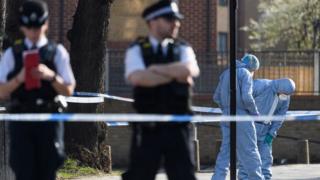 Image copyright
Getty Images
Image copyright
Getty Images
The number of knife crimes In England and Wales has risen to a new record high, says the Office for National Statistics.
There were 46,265 offences in the 12 months to the end of March this year, up 6% from the previous year.
The figures, which do not include Greater Manchester Police, were partly driven by a 7% rise in London.
However, the ONS said there was a "significant" reduction in overall offending, which fell 9%.
There was also a large rise in cases of murder and manslaughter, with 683 deaths - though the total includes the 39 people found dead inside a lorry in Essex last October.
Excluding the Essex lorry deaths, homicides increased by 3%.
Of all the killings, 256 involved a knife or sharp object, up from 250 the year before.
There were 619 offences involving a corrosive substance - such as acid - the first time the figures have been published by the ONS.
The crime statistics appear to present a contradictory picture - with estimates from the survey suggesting a reduction in offending and the police figures showing a rise.
In fact, they're measuring different things. The survey indicates how many people have experienced crime; the police data show how many offences have been reported to and recorded by forces.
For overall and long-term trends, the survey is more reliable. For instance, the ONS says there's been a drop-off for the first time in six years in the proportion of adults saying they've been the victim of a sexual assault.
This is far more likely to be an accurate gauge of what's happening than police figures, which rely to a large extent on the willingness of victims to come forward.
For some of the most serious - but comparatively less prevalent - offences, such as knife crime, the police figures are a better guide, though they make for depressing reading.
For the first time, data from the ONS Crime Survey captured the gender identity of victims of crime.
Those whose gender identity is different from that registered at birth were twice as likely (28%) to be a victim.
People of a mixed ethnic background were the most likely to have been a crime victim - 20% compared to 13% for white people. Those from an Asian background were also more likely to have experienced crime (15%).
The figures were also significantly higher for those who identified as gay, lesbian or bisexual - 21% compared to 14% of those who are straight.
These figures exclude fraud and computer use, which the ONS says are generally considered to be less targeted crimes.
However, the data from the survey, which is based on interviews with almost 34,000 people, suggest there was a 9% fall in overall offending.
The Office for National Statistics says this is a "significant" reduction, which was partly driven by steep falls in theft and criminal damage.
Sophie Sanders, from the ONS's centre for crime and justice, said: "Overall, crime rates were lower in the months leading up to the coronavirus pandemic than they were in early 2019.
"However, it will not be possible to say whether this would have come to represent a change from the trend in recent years, as the pandemic will have had an impact on the level and types of crime since March."
Image copyright Getty Images Image caption The statistics show 3.2% of sexual offences led to charges, down from 5.2% two years agoMeanwhile, the proportion of crimes in England and Wales that are solved has fallen to a new record low.
Just 7% of offences led to a suspect being charged or ordered to appear in court, in the 12 months to the end of March.
That compares with 8% the previous year and 16% in 2014-15, when the figures were first compiled in this way.
The Home Office, which published the data, said that is the equivalent of 33,460 fewer offences leading to a charge or court summons than last year.
The statistics, which cover forces in England and Wales excluding Greater Manchester Police, show 3.2% of sexual offences led to charges, down from 5.2% two years ago.
Only 1.4% of rape offences resulted in a prosecution.

 5 years ago
675
5 years ago
675 

